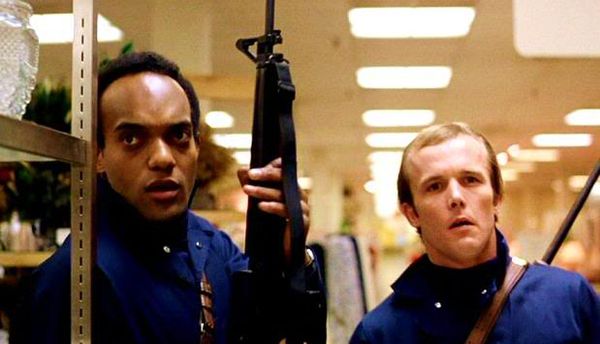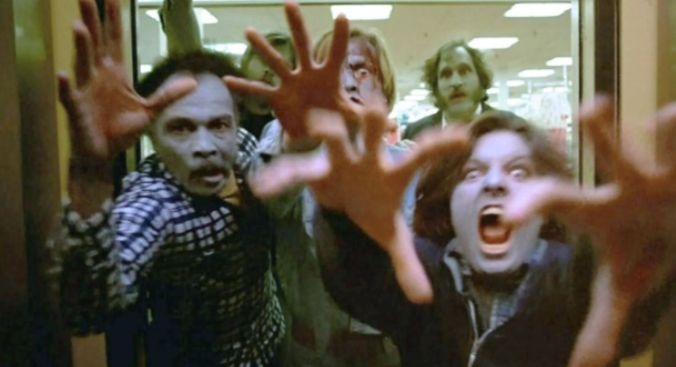Lessons from arguably the best zombie film ever made!
TODAY (THURSDAY) IS THE ‘HALLOWEEN HORROR SHOWDOWN’ DEADLINE. Get your entries in by 11:59pm tonight! The five most compelling pitches will be posted tomorrow for everyone to read and vote on. As a reminder, here’s how to enter…
What: Halloween Horror Showdown
Genre: Horror
When: Entries are due Thursday, October 21st, 11:59 PM Pacific Time
How: Include title, genre, logline, Why We Should Read, and a PDF of your script
Where: carsonreeves3@gmail.com
While I eagerly await the remainder of the horror entries, we’re going back to the zombie genre for another Halloween Horror 10 Tips! I had so much fun watching Night of the Living Dead last week, I thought we’d check out its sequel, a movie many consider to be the best zombie movie of all time. This is the movie where a group of people hole up in a shopping mall during the zombie apocalypse. Lots of good lessons to learn here!
1) Even More In Media Res – As we talked about last week, Night of the Living Dead throws us right into the action. Zombies are coming at us in the very first scene. Dawn of the Dead takes that approach and multiplies it by a thousand. We’re plopped down on a news set as zombies take over the world. Everything is falling apart in front of our eyes. People are screaming to get off the air. Newscasters are determined to stay on and keep giving the news. It’s absolute chaos. If you’ve never seen this movie, go watch it now just for the opening. It feels insanely realistic and scary. More importantly, Romero doubles down on his ‘in media res’ approach to zombies, showing us, once again, how effective it is. A tremendous opening scene (and a good follow-up scene as well).
2) Exposition Mastery – I noticed something very cool about the initial exposition being used to describe what’s happening in the world. 99% of the time in these movies, the exposition is offered through people watching the news on TV, which is a passive, and therefore, boring way to convey exposition. What Dawn of the Dead does that’s really clever is they PUT YOU IN THE ACTUAL NEWSROOM as the news is being given. Because we’re experiencing the news from the inside, as all the chaos surrounds us, the exposition feels a lot more active and compelling.
3) Create ticking time bombs WITHIN the story – When I talk about ticking time bombs, I’m often referring to the kind that frame the entire story (“The hero has 48 hours to find his missing daughter!”). But remember, you should be creating smaller “self-contained” ticking time bombs as well, as they help keep that section of the screenplay tense. For example, helicopter weatherman Stephen approaches news producer Francine and says, “Meet me out by the chopper at 9pm sharp. We’re getting out of here.” This “mini” ticking time bomb creates an intense little storyline now where we’re determined to see whether our couple gets out or not.
4) Set characters up through their reactions – I recently read a script where none of the characters stuck. I couldn’t remember them from page to page. The most common reason this happens is that the writer didn’t do enough to properly establish the character when they were introduced. A great way to establish someone is through their reactions. We see that here with Peter, the big burly SWAT team member who joins our group. He’s forced to kill a bunch of zombies who’ve been stuffed into the basement of a hotel. He must shoot each of them in the head. As he does this, one after another, he starts crying. That’s the reaction audiences latch onto. They now know this guy is a sympathetic dude who hates that he has to do this. Not only do we have a good feel for the character moving forward. But we like him as well.
5) Look for opportunities to split people up – There’s safety in numbers. Which is great in real life. But bad for horror movies. Audiences are less scared when your characters are together. Which means you should look for ways to split them up. When our heroes land their chopper for a refueling, Stephen and Francine go one way looking for supplies while Peter goes another. Now all we need is a few zombies lurking and we’ve got ourselves a couple of cool scenes to crosscut between.
6) Use your unique surroundings to create memorable moments – Not enough writers consider what’s unique about a location. Anything unique should get special attention because that’s where you’re going to give audiences things they haven’t seen before. One of the most memorable zombie kills ever occurs in Dawn of the Dead when Roger is refueling the helicopter. A zombie moves in to attack, has to climb over some boxes, and then while he’s up on the boxes, the helicopter blade slices the top of his head off. That’s way more interesting than yet another gunshot to the head. (pro-tip: A clever writer would’ve had Roger execute the kill himself, shoving the zombie up there with his own hands)
7) Old school social commentary – Probably one of the most famous examples of social commentary ever, Dawn of the Dead puts a spotlight on America’s obsession with consumption, highlighting a bunch of zombies (us) brainlessly wandering the hallways of a mall. Consume consume consume. Buy buy buy. I put this up as a reminder that if today’s highly charged social commentary topics make you squeamish, there’s other, less controversial, commentary you could be making, like Dawn of the Dead does here. If your commentary is clever enough, like “Dawn,” it will get people talking about your script for sure.
8) Start light in your second act so that it can build – Remember that your second act is going to build. So if you start out too big, you may not have anywhere to go. Romero knows we’re doing to be stuck in the mall for the whole movie so he starts off by having some fun. Have the two guys run around the mall like kids in a candy store. Everything they’ve ever wanted: absolutely free. You do this so you can start building, from “happy,” to “kinda serious,” to “serious,” to “very serious,” to “Oh shit, we’re f%$@d.”
9) Give your characters the occasional reward – Horror movies can devolve into a never-ending series of intense scenes. The monsters are getting stronger. People in the group are dying. The remaining characters are at each others’ throats. It’s important to, every once in a while, give your characters a reward that makes them feel good, and by association, makes us feel good. We get that here when our team finally gets into the gun shop. It’s a big fun moment as now they’re able to outfit themselves with a ton of weapons to take down the army of zombies. In general, there should be no singular emotion that lasts, uninterrupted, the entire screenplay. Emotion should fluctuate during a movie, from the highest of highs to the lowest of lows, and everything in between.
10) Don’t forget your relationship issues! – You have a choice when you create relationship problems between characters. You can either include a problem that’s already there at the beginning of the movie. Or you can introduce a strong relationship then add a problem to it later on. Dawn of the Dead has both. Francine is pregnant with Stephen’s baby and neither of them are sure they want to have it. That’s their issue. Peter and Roger, meanwhile, are best friends through this whole thing. There’s no problem at all. However, when Roger gets infected, Peter realizes that the time is coming where he’s going to have to kill his friend. Four characters. Two relationship issues. Both well done.



